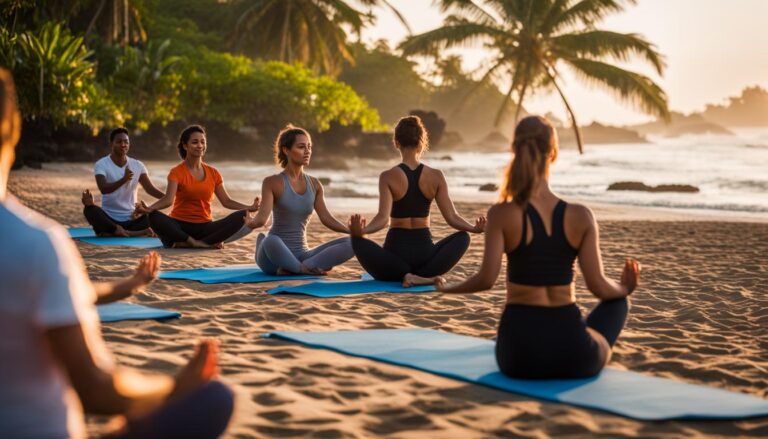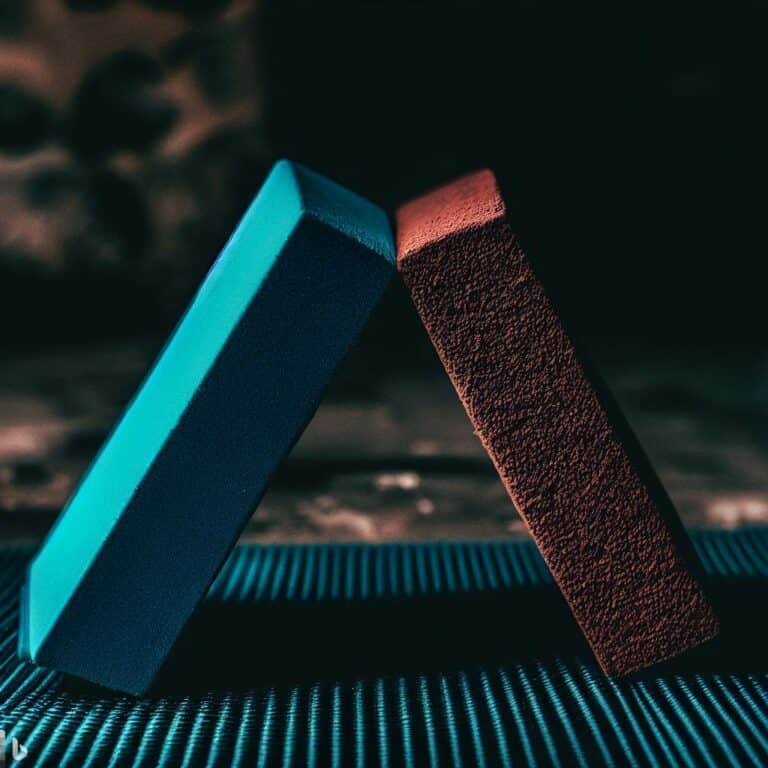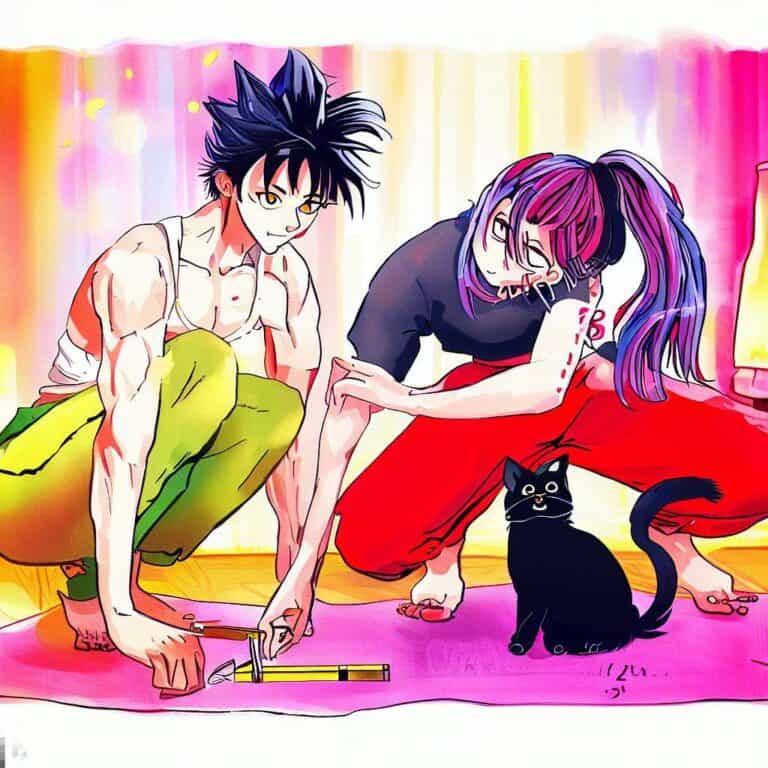Block by Block: A Comprehensive Guide to Choosing the Perfect Yoga Block

The content on this blog may contain affiliate links. If you choose to purchase through these links, I may receive a commission at no extra cost to you. Thank you for supporting my work!
The Importance of Finding the Perfect Yoga Block
Yoga blocks are essential props for any yoga practice, and can greatly enhance your overall experience. These small but mighty tools can help yogis of all levels achieve better alignment, deepen stretches, and improve balance. But with so many different types of yoga blocks on the market, how do you choose the right one for you?
- Choosing the right type of yoga block is crucial for improving your practice as a poorly chosen block can cause discomfort or injury.
- When choosing a yoga block, factors to consider include material, size and shape, density, brand reputation, and price range.
- Investing in a high-quality block can enhance your overall experience and practice.
What is a Yoga Block?
A yoga block is a rectangular or square-shaped prop used in yoga practice to provide support, stability, and extension. They are typically made of cork, foam, bamboo or other materials that can withstand wear and tear over time. Yogis use them to help support their body weight during difficult poses or when they need an extra boost to reach a new level of flexibility.
The Importance of Choosing the Right Yoga Block
Choosing the right type of yoga block is crucial for improving your practice. A poorly chosen block can cause discomfort or even injury if it isn’t sturdy enough to support your weight. A block that’s too small or light won’t provide enough stability when balancing on one foot, while a block that’s too heavy might be difficult to lift in certain positions.
By selecting the right material density, size and shape based on your individual needs and preferences you can take full advantage of this versatile tool and enjoy enhanced benefits from incorporating them into your daily practice. In this article we will explore all the necessary factors in depth so you have everything you need to make an informed decision when choosing the perfect yoga block for you!
Material: Choosing the Right Type of Yoga Block
When it comes to yoga blocks, there are a variety of materials to choose from. The most common materials are cork, foam, bamboo, and wood. Each material has its own set of pros and cons that should be taken into consideration when choosing the right yoga block for you.
Cork Yoga Blocks
Cork is a popular material for yoga blocks because of its natural texture and firmness. Cork blocks are also eco-friendly since they come from renewable sources. Cork yoga blocks provide excellent support during poses and are durable enough to withstand frequent use.
One potential downside to cork blocks is that they tend to be pricier than other options. They may also have an earthy smell when first purchased, but this typically goes away after some use.
Foam Yoga Blocks
Foam yoga blocks are lightweight and affordable. They come in a variety of colors and densities, making them customizable to your individual needs. Foam blocks provide a soft surface for both beginners and experienced yogis.
However, foam isn’t as eco-friendly as other materials since it’s made from synthetic materials. Foam can also wear down over time with frequent use.
For a detailed comparison between cork yoga blocks and foam yoga blocks read this article: Block It Out: A Comprehensive Comparison of Cork and Foam Yoga Blocks.
Bamboo or Wood Yoga Blocks
Bamboo or wood yoga blocks are sturdy and provide excellent support for both beginners and advanced practitioners alike. They’re also eco-friendly since they’re made from sustainable sources. However, bamboo or wood yoga blocks tend to be heavier than other options, making them less portable if you plan on taking them with you to a class or on the go.
They can also be more expensive than foam options due to their natural beauty and durability. When choosing your preferred material for your yoga block, consider factors such as affordability, durability, sustainability, weight/portability options for travel purposes among others before settling on any given option.
Size and Shape
Yoga blocks come in various shapes and sizes, but the most common shape is rectangular with dimensions of 9 x 6 x 3 inches. This size is considered the standard size for most yoga practitioners. It’s a good size for supporting your weight while not being too bulky to carry around.
The rectangular shape also provides a stable base for standing postures and can be used in a variety of ways during practice. While the standard size works well for many, some people may require variations due to their body type or personal preferences.
For example, those with smaller hands may find that a smaller block (8 or 7 inches) is more comfortable to grip during certain poses. Alternatively, some people with larger body types may prefer larger blocks (10 or 11 inches) as they provide more surface area for support.
Another consideration when it comes to shape is whether you want a curved or straight block. Curved blocks have a rounded edge that can be beneficial during certain poses, such as placing it under your back during bridge pose to create more space in your chest and shoulders.
The Importance of Finding Your Perfect Size and Shape
Finding the right size of yoga block can greatly enhance your practice, making it more comfortable and effective. Using blocks that are too small or too large can lead to discomfort or instability during poses, which can ultimately hinder progress in your practice.
Similarly, choosing between curved or straight blocks can make certain poses easier or harder depending on what you’re looking for. For example, if you’re working on opening up your hips during pigeon pose, using a curved block under your hip may allow you to deepen the stretch without sacrificing stability.
Ultimately, experimentation is key when it comes to finding the right size and shape of yoga block for you. Try out different options at your local studio or gym before making a purchase so you can feel confident in your decision.
Density: The Importance of Choosing the Right Firmness
When it comes to yoga blocks, density is an essential factor to consider. Density refers to the level of firmness or hardness of the block and can vary from soft and squishy to hard as a rock. The density you choose will depend on your experience level and intended use. Different Levels of Density Available for Yoga Blocks
Yoga blocks come in three levels of density: soft, medium, and hard. Soft blocks are suitable for beginners or those recovering from injuries as they provide a gentle support system.
Medium-density blocks are firmer than soft ones but still provide enough give for comfort during poses. Hard blocks are the most durable and provide a robust foundation that is ideal for more advanced yogis. How to Choose the Right Density Based on Experience Level and Intended Use
Choosing the right density for your yoga block depends on both experience level and intended use. If you’re new to yoga or recovering from an injury, start with a softer block that offers more give during poses. Soft blocks are also great for restorative practices where you need extra support.
As you advance in your practice, move up to medium-density blocks. These provide more stability during challenging poses like balancing postures or inversions.
Medium-density blocks also work well as props for standing postures or backbends. If you’re an experienced yogi looking for a long-lasting investment in your practice, go with a hard block that provides maximum support during advanced poses like arm balances or deep lunges.
Overall, choosing the right density yoga block is crucial for unlocking new levels in your practice while preventing injury along the way. Take time to consider your experience level and intended use before making your purchase so that you can get the most out of every pose with confidence!
Brand Reputation
Researching reputable brands that produce high-quality yoga blocks
When it comes to choosing a yoga block, you want to make sure that you are investing in one that is made by a reputable brand. This means doing some research to find out which companies are known for producing high-quality yoga blocks. Some of the most popular brands include Manduka, Jade Yoga, and Gaiam.
One way to research these brands is by looking at their websites. Here, you can read about their manufacturing processes and the materials they use in their products.
You can also find out if they have any certifications or awards for their products. Another way to research these brands is by reading reviews from other yogis.
There are many online forums and social media groups where people share their experiences with various yoga blocks. Reading these reviews can give you an idea of which brands are most popular and which ones have a good reputation in the yoga community.
Reading reviews from other yogis
Reading reviews from other yogis is an important part of researching yoga block brands. You want to get an idea of how people feel about the products they have used, including both positive and negative feedback.
When reading reviews, look for comments on the durability, comfort, and overall quality of the product. You may also want to pay attention to comments about the customer service provided by the brand in case you have any issues with your purchase.
It’s also important to consider how many reviews a particular product has received. If a product has hundreds or thousands of reviews, it may be more reliable than one with only a handful of reviews.
In addition to online forums and social media groups, many retailers allow customers to leave reviews on their website. Make sure to check multiple sources before making your final decision on which brand to choose for your new yoga block!
Price Range
Understanding the price range for different types of yoga blocks
Yoga blocks come in a wide range of prices, from as little as $5 up to $50 or more. The price you pay for your yoga block will depend on a variety of factors, including the material it’s made from, its size and shape, and its level of quality.
While it can be tempting to go for the cheapest option available, keep in mind that a high-quality yoga block will last longer and provide more support than a cheaper one. Cork yoga blocks are generally more expensive than foam or bamboo blocks because cork is a natural material that is sustainably harvested.
Foam blocks tend to be the least expensive option because they are made from synthetic materials that are easy to produce. Bamboo blocks fall somewhere in between cork and foam in terms of price, as bamboo is an eco-friendly material that is also durable.
Determining a budget based on personal needs
When determining your budget for a yoga block, consider how often you plan to use it and what kind of support you need. If you’re new to yoga or only practice occasionally, a budget-friendly foam block may be all you need.
However, if you practice regularly or have specific alignment needs, investing in a higher-quality cork or bamboo block may be worth the extra cost. It’s also important to think about your own personal values when setting your budget.
If sustainable materials or supporting ethical companies are important to you, factor that into your decision-making process as well. Ultimately, your budget will depend on your individual needs and priorities.
Remember that buying a high-quality yoga block can be seen as an investment in your practice and overall wellbeing. Choose wisely based on what’s important to you!

Conclusion
Recap of important factors to consider when choosing a yoga block
Choosing the right yoga block can greatly enhance your practice, but with so many options available, it can be overwhelming. Remember to consider the material, size and shape, density, brand reputation, and price range before making a purchase.
Cork blocks are sturdy and eco-friendly while foam blocks are lightweight and soft. The standard size of a yoga block is 4 inches by 6 inches by 9 inches, but there are variations based on personal preference or body type.
Density levels vary from soft to firm, depending on experience level and intended use. Brand reputation is also important when choosing a yoga block.
Read reviews from other yogis and do some research on reputable brands that produce high-quality blocks. Determine your budget based on personal needs.
Encouragement to invest in a high-quality block for optimal practice
Investing in a high-quality yoga block will not only enhance your practice but also prevent injuries by providing proper support during poses. Cheaper blocks may not be as durable or offer enough stability for certain poses. A quality block can last for years if properly cared for and will ultimately save you money in the long run.
Don’t sacrifice quality over price when it comes to investing in your health and wellness through yoga practice. Take the time to find the perfect yoga block that suits your needs and enhances your practice experience with optimal support and stability.
Choosing the best yoga block requires careful consideration of various factors such as material type, size and shape, density level, brand reputation, and price range. By investing in a high-quality block that meets all these requirements will help improve your overall practice experience while ensuring adequate support during poses leading to injury prevention – ultimately enhancing both physical fitness goals as well as mental clarity which is critical for achieving inner peace.
More reading?
This article is the main articles in a series of articles on the topic of choosing the perfect yoga block. Other articles in this series include:
- Types of yoga blocks: Which one is right for you?
- Block It Out: A Comprehensive Comparison of Cork and Foam Yoga Blocks
- Om Your Way to Sustainability: The Benefits of Natural Rubber Yoga Blocks
- Finding Your Perfect Fit: A Comprehensive Guide to Yoga Block Sizes
- A Guide to Choosing the Perfect Shape Yoga Block for Your Practice




